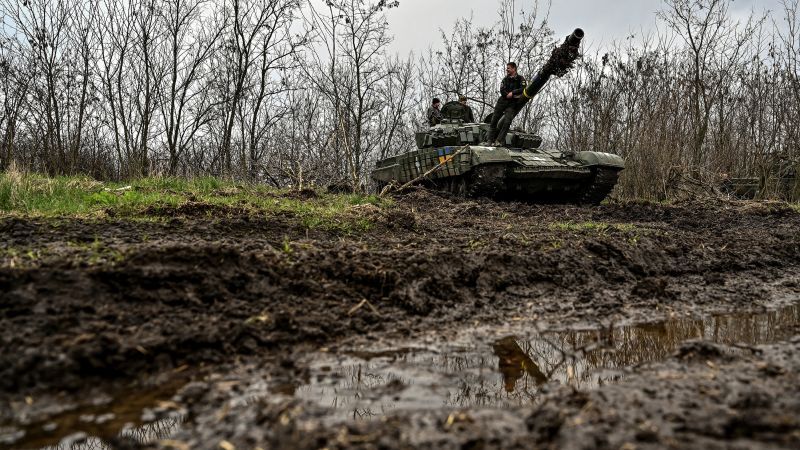Ukraine: Silence along southern front fuels speculation over counteroffensive
Zaporizhzhia, Ukraine CNN —
Miles of empty fields where you might expect a build-up of armor. Tank tracks that emerge in the mud from nowhere, and lead there too. Distant artillery duels that locals say peak and ebb.
The silence is beginning to be telling. Ukraine has made extraordinary efforts to conceal the start of its strategically vital counteroffensive. Like with its fast and smart push around Izyum and Kharkiv in the late summer last year, we may only learn of success once it has been conclusively achieved.
Ukraine’s Deputy Defense Minister Hanna Maliar stated last week that the counteroffensive would not be announced.
Russia, for its part, is also reluctant to speak of Ukrainian momentum, perhaps in case that shatters flaky morale among its own troops; little, too, has emerged from its side. Just Sunday, the US-based Institute for the Study of War reported comments by Russian military bloggers suggesting that Ukrainian forces had crossed the Dnipro River near Kherson – in small numbers, but in places where Moscow would prefer to think they were not.
It was unclear how sustained or unprecedented the apparent small Ukrainian landings were, or how they fitted in to Ukraine’s wider plan. Ukraine’s Southern Command said little but opaquely called for “patience.” Its spokesperson, Natalia Humeniuk, said: “The conditions of the military operation require information silence until it is safe enough for our military.”
A Ukrainian serviceman is seen at an artillery position in Zaporizhzhia, Ukraine, on March 25, 2023. Muhammed Enes Yildirim/Anadolu Agency via Getty Images
Over the past 10 days, Ukraine has been noticeably silent about the whole Zaporizhzhia area where its counteroffensive is largely expected. Only there can its military separate the occupied peninsula of Crimea from occupied territory in eastern Ukraine and the Russian mainland.
There have been tiny comments from Russia’s legion of military bloggers who have been, given the tight operational security deployed by Kyiv, often the first source of information about Ukrainian maneuvers in the past offensives. Kopani, Marfopil, Kamianske, Polohy – these are all places where pro-Russian bloggers have suggested Ukrainian attempts to move forward. The evidence for these claims is frustratingly unclear, and bloggers have a poor track record.
Local residents take cover at the basement of a shelter waiting for the artillery shelling to stop close to the front line in the town of Orikhiv on April 12, 2023. Andriy Andriyenko/SOPA Images/LightRocket via Getty Images
Russian aviation is also trying to hit what it thinks are Ukrainian targets. The town of Orikhiv, about 40 miles southeast of Zaporizhzhia, has seen the repeated bombardment of anything that might resemble a military hub: a sports school, a farming warehouse - empty buildings now featuring a vast crater. The tiny settlement of Vuhledar, on the further eastern end of where Ukraine might launch a counteroffensive in the south, has been hit by several heavy airstrikes in the past 48 hours.
The intense and indiscriminate Russian firepower suggests the high stakes of the weeks ahead. This is a fight that Moscow has known is coming for six months.
The Russians have had ample time to prepare. Russian President Vladimir Putin himself even visited the theater of war last week and met with the head of the airborne forces, Mikhail Teplinsky, whose paratroopers will be at the forefront of any defense. They have dug networks of winding trenches and defenses, which Ukrainian troops will likely either stumble on, or just go around.
It is a decisive moment in the war for the Kremlin. Russia’s leaders have publicly invested what little resources they have left in a so-far unsuccessful push for the strategically unimportant city of Bakhmut in the Donetsk region of eastern Ukraine.
The enormous losses on both sides, over a savage winter in which the city has been mauled beyond recognition, have not reflected the small advantage Russia would have if it eventually gained control of the entire city. It has yet to do so, and – as now is often the case – would be the victors over uninhabitable rubble.
A crater is seen in a residential area after a rocket strike by the Russian military in Zaporizhzhia, Ukraine, on April 9, 2023. Dmytro Smolienko/Ukrinform/Future Publishing via Getty Images
Gains for Ukrainian forces in Zaporizhzhia, however, could strike a more potent blow to Russia’s wider campaign. It is the land corridor from occupied Donbas to occupied Crimea – the piece of territory seized by Russia last year that is in the long term the most useful, linking by land a peninsula annexed in 2014 with the Russian mainland.
Losing this would greatly imperil Russia’s military in Crimea and split its occupation in two. It would also betray the strategic incompetence of its military, if they were unable to prevent this most glaringly obvious of Ukrainian ambitions.
This is also as decisive a moment for Kyiv. NATO has been uncharacteristically united and bold in its support and arming of Ukraine. This sort of clarity of purpose is an outlier in Western democracies, and one that elections, economic variables, and other distractions may dilute in the year ahead. Ukraine cannot count on this level of support this time next year, whatever the press releases today say.
The Ukrainians face an enemy weaker than it has been for months, with the Russians even sending wounded convicts back to fight on the frontline, according to accounts from convict recruits.
Kyiv’s forces have better weaponry and training from NATO than ever before. And they surely have good, real-time information from their Western allies to pry open any advantage.
And the silence that we see now – the near total absence of TikToks or commentary from the Zaporizhzhia front line – may be the clearest indicator yet that this vital step is afoot.
Source: CNN


